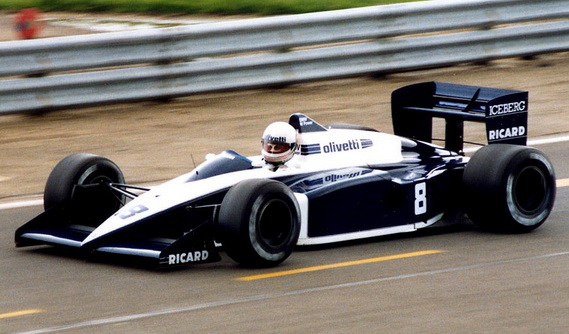1987 Brabham BT56

The descriptions of the Classic Cars in the Directory were partly generated or supplemented with the help of artificial intelligence (AI). The content may occasionally not always be entirely accurate or factually correct despite careful checking.
The Brabham BT56 1987 was a single-seat racing car designed and manufactured by the renowned constructor Brabham Racing Organisation. The BT56 was built to compete in the 1987 Formula One World Championship and was raced by the Australian driver Riccardo Patrese and the British driver Andrea de Cesaris.
The BT56 showcased Brabham's state-of-the-art aerodynamics and was designed to produce maximum downforce, allowing it to corner at high speeds. The car featured a sleek and narrow body, with a low profile and distinctive bulbous nose.
Underneath the bodywork, the BT56 was powered by a turbocharged BMW four-cylinder engine that produced 1,000 horsepower, making it one of the most powerful cars in the field. The engine was mated to a six-speed manual gearbox that allowed for quickly shifting through the gears with precision.
The suspension system of the BT56 featured a combination of double-wishbone front suspension and a rear pushrod suspension. The car also had anti-roll bars, spring rates, and damper settings which could be adjusted according to the track's characteristics.
The BT56's wheels were specially designed BBS rims, always equipped with the distinctive Pirelli P Zero racing tires to provide optimal traction on any type of track. Brakes were carbon fiber discs and pads, which effectively dissipated heat and provided an excellent stopping power. The car featured a hydraulic system that applied pressure to the disc brakes, allowing the driver to slow down quickly with a simple squeeze of the brake pedal.
Inside the cockpit, the BT56 impressed with its ergonomics and functionality. The car featured a rectangular racing steering wheel and a comprehensive set of gauges and switches that allowed the driver to adjust various settings while driving at high speeds. The seat was custom-made for the driver, ensuring optimal driving position and support during high gravitational forces.
Overall, the Brabham BT56 1987 was an impressive machine that showcased Brabham's state-of-the-art technology and engineering expertise. The car's combination of power, speed, and agility made it a formidable competitor on any track, and it showed in the hands of drivers like Patrese and de Cesaris. The BT56 remains a testament to Brabham's racing legacy and a revered piece of motorsport history.
Milestones
- January 1987: Development of Brabham BT56 begins - February 1987: First track testing of BT56 with driver Riccardo Patrese - March 1987: Unveiling of Brabham BT56 at a pre-season launch - April 1987: BT56 makes its debut at the Brazilian Grand Prix with Patrese and team newcomer Andrea de Cesaris as drivers - May 1987: Patrese takes the first points for BT56 with a sixth-place finish at the Monaco Grand Prix - July 1987: De Cesaris secures the team's first podium finish of the season with a third place at the French Grand Prix - September 1987: Patrese claims pole position at the Italian Grand Prix, the first for Brabham since 1985 - October 1987: De Cesaris finishes fourth at the Mexican Grand Prix, securing fifth place in the Drivers' Championship for him and the team - November 1987: Brabham finishes fourth in the Constructors' Championship for the season, behind Williams, McLaren and Ferrari.Technical
• Chassis: Carbon fiber and honeycomb composite Monocoque • Suspension: Double wishbone and pull-rod activated inboard springs and dampers • Engine: BMW M12/13/1, 1.5 L, inline 4-cylinder Turbocharged engine • Power: 950 bhp (708 kW) @ 12,400 rpm • Transmission: Brabham / Hewland 6-speed manual gearbox • Weight: 540 kg • Wheelbase: 2.74 m • Front Track: 1.48 m • Rear Track: 1.38 m • Fuel Capacity: 195 L • Brakes: AP Racing Disc Brakes • Tyres: Goodyear Tires • Top Speed: Around 330 km/h (205 mph)